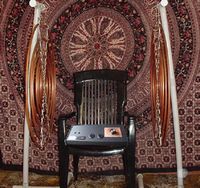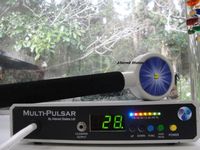Melatonin and cancer
Melatonin--is an immune modulator that increases the survival time of most
cancer patients
Some cancer patients are now taking melatonin, an immune-modulating neurohormone,
as part of a comprehensive, nontoxic cancer treatment. The cone-shaped
pineal body, a small but crucial gland located in the brain, produces
melatonin, a hormone that influences sexual maturation but also appears
to play an important role in cancer.
Melatonin supplementation appears to restore circadian rhythms, which diminish or disappear with age. When melatonin's circadian rhythm is abolished, the aging process is accelerated, life span is shortened, and an increase in spontaneous tumors occurs (Maestroni 1999). It has been shown that when the defense system is compromised due to disrupted rhythms, tumors grow two to three times faster (Filipski et al. 2002).
Melatonin also protects and restores normal blood-cell production caused by the toxicity of conventional treatments; a profile shared with the FDA-approved drugs Neupogen, a granulocyte colony-stimulating factor (G-CSF), and Leukine, a granulocyte-macrophage colony-stimulating factor (GM-CSF). A combination of melatonin and low-dose interleukin 2 (IL-2) neutralizes treatment-induced lymphocytopenia, a decrease in the numbers of lymphocytes in the peripheral circulation of cancer patients (Lissoni et al. 1993).
Researchers found the best way to amplify the antitumoral activity of low dose IL-2 is by not coadministering another cytokine but rather cosupplementing with the immune-modulating neurohormone melatonin (Lissoni et al. 1994a). This is hopeful news for a subset of cancer patients, because melatonin has been shown to cause tumor regression in neoplasms nonresponsive to IL-2 (Maestroni 1999).
The Division of Radiation Oncology of the San Gerardo Hospital (Milan) developed the following protocol for 80 patients with advanced metastatic tumors (Lissoni et al. 1994a). The patients were randomized to receive 3 million IU of IL-2, 6 days a week, for 4 weeks or IL-2 plus 40 mg a day of melatonin. A complete response was achieved in 3 of 41 patients treated with IL-2 plus melatonin and in none of the patients receiving only IL-2. A partial response occurred in 8 of 41 patients treated with IL-2 plus melatonin and in 1 of 39 patients treated with IL-2. Tumor regression rate was significantly higher in patients using IL-2 and melatonin compared to those receiving IL-2 (11/41 versus 1/39). The survival rate at 1 year was higher in patients treated with IL-2 and melatonin than in the IL-2 group (19/41 versus 6/39). Lymphocytic populations were consistently higher when melatonin accompanied the treatment and thrombocytopenia (a decrease in the number of circulating platelets) occurred less frequently.
For patients with bloodborne cancers, an IL-2/melatonin combination is also promising. Twelve patients (nonresponsive to standard therapies) evaluated the efficacy and tolerability of a combination of low-dose IL-2 plus melatonin in advanced malignancies of the blood, including non-Hodgkin's lymphoma, Hodgkin's disease, acute myelogenous leukemia, multiple myeloma, and chronic myelomonocytic leukemia. IL-2 was given 6 days a week for 4 weeks, along with oral melatonin (20 mg a day). Cancer was stabilized and did not progress in 8 of 12 (67%) participants for an average duration of 21 months. An additional benefit accrued as the melatonin/IL-2 therapy was well-tolerated (Lissoni et al. 2000).
Nonresectable brain metastasis remains an untreatable disease. Because of melatonin's cytostatic action (the ability to suppress the growth of cells) and its anticonvulsant activity, the pineal hormone may prove effective in the treatment of brain metastasis. In a study to test the theory, 50 patients with inoperable brain metastasis were given supportive care or supportive care plus 20 mg of melatonin nightly. Freedom from brain tumor progression and survival rates at 1 year were higher in patients who were treated with melatonin compared to those who received only supportive care (Lissoni et al. 1994b, 1996). Even when melatonin was unable to stop the progression of advanced, metastatic disease, it improved the performance status of patients (see Table 2).
Low melatonin levels play a role in escalating rates of breast cancer. As melatonin levels decrease, the secretion of estrogen increases. Nighttime production of melatonin inhibits the body's secretion of estrogen and decreases the proliferation of human breast cancer cells. Conversely, exposure to light during the night decreases melatonin production and increases cumulative lifetime estrogen levels, a sequence that may increase the risk of breast cancer.
In fact, two current studies show that women who work night shifts may increase their risk of breast cancer up to 60%. Blind women have a significantly lower risk (36% less) of breast cancer than normally sighted women because of consistently higher levels of melatonin (Kliukiene et al. 2001). Women, who are classed as only visually impaired, realize no protective effects in regard to breast cancer.
Table 2: Summary of Studies Using Melatonin (Lissoni's Phase II Randomized
Clinical Trial Results)
1-Year Survival
Tumor Type Patient Number Basic Therapy Melatonin Dose Melatonin Placebo
Level of Significance
Metastatic non-small cell lung 63 Supportive care only 10 mg 26% under
1% <0.05
Glioblastoma 30 Conventional radiotherapy 10 mg 43% under 1% <0.05
Metastatic breast 40 Tamoxifen 20 mg 63% 24% <0.01
Brain metastases 50 Conventional radiotherapy 20 mg 38% 12% <0.05
Metastatic colorectal 50 IL-2 40 mg 36% 12% <0.05
Metastatic nonsmall cell lung 60 IL-2 40 mg 45% 19% <0.05
Compiled by Cancer Treatment Centers of America and published in the March
2002 issue of Life Extension Magazine.
Cancer Adjuvant Therapy
It appears that melatonin may also reduce the number of estrogen receptors on breast cancer cells. Since estrogen effectively feeds the growth of hormone-responsive breast tumors, reducing the receptors might slow tumor growth. Science News reported that the amount of melatonin required to inhibit breast cell proliferation appears no greater than the amount commonly present in human blood at night (Science News 93; Moss 1995).
Electromagnetic fields (EMFs) are another inhibitor of melatonin production. There is evidence that ELF (extremely low frequency) magnetic fields can act at the cellular levels to enhance breast cancer cell proliferation by blocking melatonin's natural oncostatic action. The mechanism(s) of action is unknown and may involve modulation of signal transduction events associated with melatonin's regulation of cell growth (Liburdy et al. 1993)
Melatonin delivers another anticancer perk through its antioxidant values. Physicians who once credited glutathione and vitamin E as being antioxidants of choice have now given special honor to melatonin. The neurohormone appears to protect against tumors by shielding molecules (especially DNA) from oxidative stress. Melatonin exerts its antioxidant properties by detoxifying the highly reactive hydroxyl radical, as well as singlet oxygen, hydrogen peroxide, and peroxynitrite anions (Kim et al. 2000).
A typical dose for a healthy individual is 300 mcg-6 mg each night. Cancer patients often take between 3-20 mg each night.
 |
The worlds most advanved multi purpose Fully Automatic Rife/Hoyland System here |
 |
Rife machines and Multiwave oscillators are claimed to complement each other based on the principle that life forms absorb energy. A multiwave Oscillator uses this principle to strengthen cells within the body to resist disease while a Rife machine uses this principle to destroy microorganisms with an overdose of frequency energy. |
 |
PEMF Pulser combo |